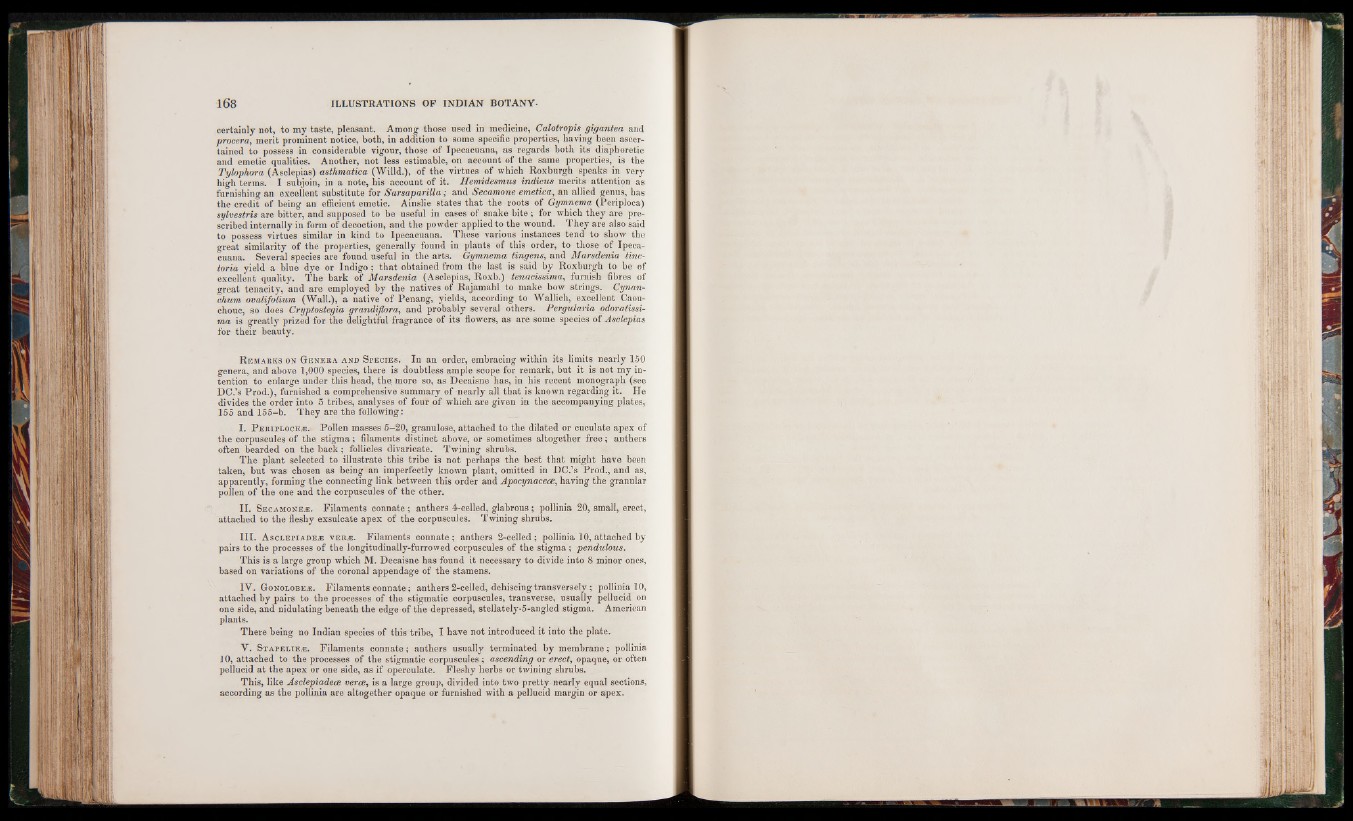
certainly not, to my taste, pleasant. Among those used in medicine, Calotropis gigantea and
procera, merit prominent notice, both, in addition to some specific properties, having been ascertained
to possess in considerable vigour, those of Ipecacuana, as regards both its diaphoretic
and emetic qualities. Another, not less estimable, on account of the same properties, is the
Tylophora (Asclepias) asthrnatica (Willd.), of the virtues of which Roxburgh speaks in very
high terms. I subjoin, in a note, his account of it. Hemidesmus indicus merits attention as
furnishing an excellent substitute for Sarsaparilla; and Secamone emetica, an allied genus, has
the credit of being an efficient emetic. Ainslie states that the roots of Gymnema (Periploca)
sylvestris are bitter, and supposed to be useful in cases of snake bite; for which they are prescribed
internally in form of decoction, and the powder applied to the wound. They are also said
to possess virtues similar in kind to Ipecacuana. These various instances tend to show the
great similarity of the properties, generally found in plants of this order, to those of Ipeca-
cuana. Several species are found useful in the arts. Gymnema tingens, and Marsdenia tinc-
toria yield a blue dye or Indigo; that obtained from the last is said by Roxburgh to be of
excellent quality. The bark of Marsdenia (Asclepias, Roxb.) tenacissima, furnish fibres of
great tenacity, and are employed by the natives of Rajamahl to make bow strings. Cynan-
chum ovalifolium (Wall.), a native of Penang, yields, according to Wallich, excellent Caou-
chouc, so does Cryptostegia grandiflora, and probably several others. Pergularia odorqtissi-
ma is greatly prized for the delightful fragrance of its flowers, as are some species of Asclepias
for their beauty.
R emarks on Genera and Species. In an order, embracing within its limits nearly 150
genera, and above 1,000 species, there is doubtless ample scope for remark, but it is not my intention
to enlarge under this head, the more so, as Decaisne has, in his recent monograph (see
DC.’s Prod.), furnished a comprehensive summary of nearly all that is known regarding it. He
divides the order into 5 tribes, analyses of four of which are given in the accompanying plates,
155 and 155-b. They are the following:
I. P eriplocee. Pollen masses 5-20, granulose, attached to the dilated or cuculate apex of
the cOrpuscules of the stigma; filaments distinct above, or sometimes altogether free; anthers
often bearded on the back; follicles divaricate. Twining shrubs.
The plant selected to illustrate this tribe is not perhaps the best that might have been
taken, but was chosen as being an imperfectly known plant, omitted in JDC.’s Prod., and as,
apparently, forming the connecting link between this order and Apocynacece, having the granular
pollen of the one and the corpuscules of the other.
II. Secamonee. Filaments connate; anthers 4-celled, glabrous; pollinia 20, small, erect,
attached to the fleshy exsulcate apex of the corpuscules. Twining shrubs.
III. Asclepiadee verji. Filaments connate; anthers 2-celled; pollinia 10, attached by
pairs to the processes of the longitudinally-furrowed corpuscules of the stigma; pendulous.
This is a large group which M. Decaisne has found it necessary to divide into 8 minor ones,
based on variations of the coronal appendage of the stamens.
IV. Gonolobee. Filaments connate; anthers 2-celled, dehiscing transversely; pollinia 10,
attached by pairs to the processes of the stigmatic corpuscules, transverse, usually pellucid on
one side, and nidulating beneath the edge of the depressed, stellately-5-angled stigma. American
plants.
There being no Indian species of this tribe, I have not introduced it into the plate.
V. Stapeliee. Filaments connate; anthers usually terminated by membrane; pollinia
J 0, attached to the processes of the stigmatic corpuscules; ascending or erect, opaque, or often
pellucid at the apex or one side, as if operCulate. Fleshy herbs or twining shrubs.
This, like Asclepiadece verce, is a large group, divided into two pretty nearly equal sections,
according as the pollinia are altogether opaque or furnished with a pellucid margin or apex.